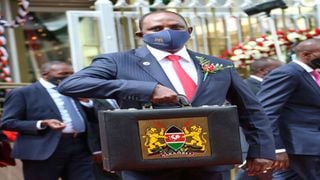
Treasury Cabinet Secretary Ukur Yatani displays the budget briefcase at The Treasury before leaving for Parliament Buildings for the reading of 2021/2022 annual budget on June 10, 2021.
| Sila Kiplagat | Nation Media GroupFinance and Markets
Premium
Kenya borrowed Sh73bn from April to August
What you need to know:
- Kenya borrowed Sh25.45 billion from the International Monetary Fund (IMF) on April 1 through the Extended Credit Facility (ECF).
- In May, Kenya also went shopping for a fresh Sh1.29 billion loan for Phase II of the Medical Waste Management Project from Belgium.
Keeping Kenya Power afloat, buying medical waste treatment plants and boosting livestock production are among the reasons Kenya borrowed Sh73 billion per month between April and August this year.
A report by the National Treasury submitted to Parliament on Tuesday shows Kenya took 10 loans amounting to Sh293 billion in that period.
The country took seven loans from multilateral lenders, two from bilateral lenders and one from the International Sovereign Bond.
Section 31(3) of the Public Finance Management Act, 2012 requires Treasury to submit a report to Parliament every four months showing the government’s borrowings from external creditors and how the money was (to be) used.
Kenya borrowed Sh25.45 billion from the International Monetary Fund (IMF) on April 1 through the Extended Credit Facility (ECF) for direct budgetary support, followed by a further Sh53.02 billion from the same lender through the Extended Fund Facility (EFF).
Treasury will repay the two loans from October 2026 to April 2031 in 10 and 12 semi-annual tranches of Sh8.68 billion and Sh16.5 billion respectively.
In May, Kenya also went shopping for a fresh Sh1.29 billion loan for Phase II of the Medical Waste Management Project from Belgium for purchase and installation of 15 AMB Series 250 Ecosteryl medical waste treatment plants.
Largest loan
The government followed this up with another loan amounting to Sh1.2 billion from CBC Banque SA to source materials from Belgium to be used for the same project.
In June, Kenya once again went to Saudi Arabia for a Sh2.2 billion loan from the Saudi Fund for Development and an additional Sh1.65 billion from the Arab Bank for Economic Development for the construction of a 90-kilometre road between Samatar and Wajir.
The road is expected to ease movement of people and goods between Wajir, Garissa, Mandera and Isiolo.
Meanwhile, the government took a Sh2.07 billion loan from the International Fund for Agricultural Development (IFAD) to be used in the Kenya Livestock Commercialisation Project (KeLCoP).
The project aims at boosting livestock production and market development for 110,000 pastoralist households.
One of the largest loans was the Sh82.62 billion borrowed from the International Development Association (IDA) in June to fund fiscal reforms in key sectors of the economy.
The loan will be used to prop up loss-making power utility Kenya Power, which is heaving under a mountain of debt exceeding Sh109 billion, and accelerate energy sector reforms.
In July, Kenya returned to the lenders for a Sh13.84 billion for facilitation of the Kenya Covid-19 Health Emergency Project, raising the total loans from IDA in the period to Sh101.08 billion.
This is in addition to Sh110.16 billion from the June Eurobond issue through Citi Group Global Markets Europe AG for development spending.
Government spending
The Eurobond was the fourth to be issued by the government following the debut Sh298 billion issue in 2014, Sh217 billion issue in 2018 and the subsequent Sh97 billion and Sh130 billion Eurobonds that were raised in 2019.
This came as a report by the Controller of Budget on government spending for the financial year 2020/21 shows a significant portion of the latest loans were used to retire old one and pay salaries and allowances, contrary to the law.
“On June 22, 2021, the National Treasury received Sh80.78 billion from the International Monetary Fund as a semi-concessional loan for budget support. However, analysis of available data shows that Sh105.05 million from the total funds received was used to fund recurrent activities in the approved national government budget,” CoB Margaret Nyakang’o said.
Dr Nyakang’o added that Treasury also used Sh18.16 billion from its latest Eurobond issue to support recurrent expenditure.
“The two examples provide instances where the government contravened Article 201(c) of the Constitution and Section 15(2) (c) of the PFM Act, 2012, which states that “over the medium term, the national government’s borrowings shall be used only for the purpose of financing development expenditure and not for recurrent expenditure,” she said.
The report indicates use of loan money to repay debt and to pay salaries dented efforts to spur economic growth by misallocating funds meant for development.
The report shows recurrent expenditure grew to 68.1 per cent (Sh2.34 trillion) of the budget last year, up from 64 per cent (Sh2.02 trillion) in FY 2019/20, while development expenditure shrank as a share of the annual budget to 20.7 per cent (Sh705 billion) from 24 per cent (Sh762 billion) in the previous year.





